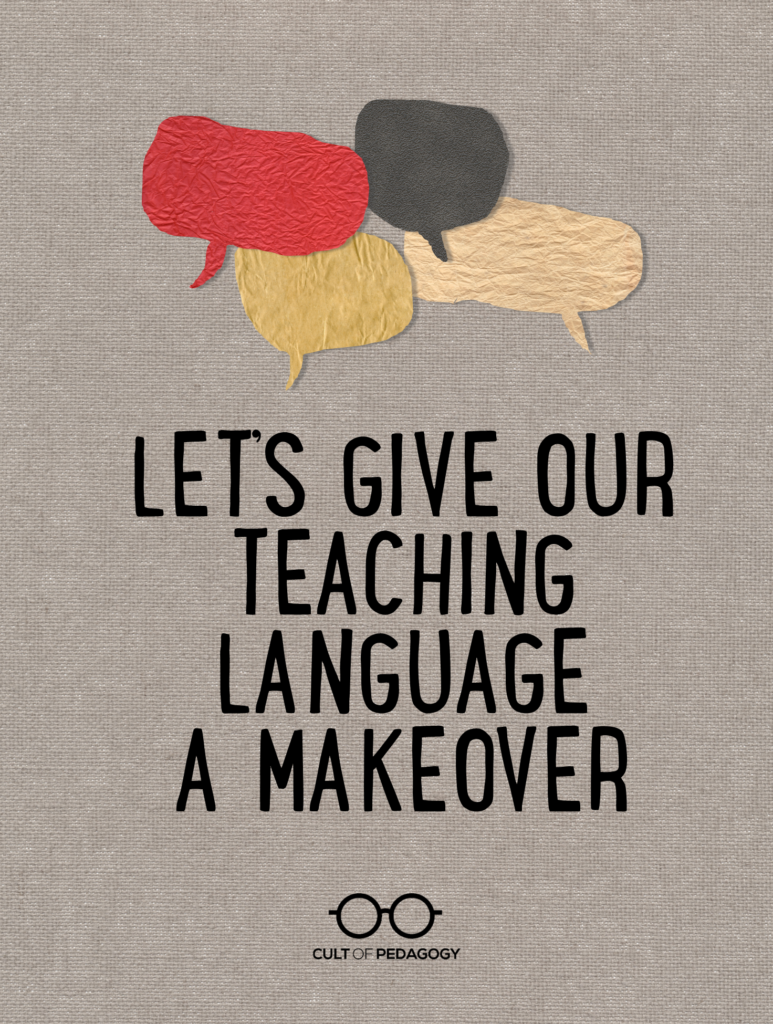
Listen to this post as a podcast:
Sponsored by Listenwise and NewseumED
This post contains Amazon Affiliate links. When you make a purchase through these links, Cult of Pedagogy gets a small percentage of the sale at no extra cost to you.
Consider two classrooms: Room 1 and Room 2. The students in both rooms are working in groups on an activity, and in each room, one of the groups has gotten off task.
In Room 1, the teacher approaches the off-task group and says to them, “Get back to work or you’ll be staying in for recess!”
In Room 2, the teacher approaches the off-task group and says, “This is not like you. What’s the problem?” and then, after students explain the problem, follows up with, “Okay, how do we solve that?”
In both cases, the teacher addresses the off-task behavior, but the language each one uses is completely different. The first teacher is threatening a consequence, sending the message that the activity’s only real value is avoiding punishment. By contrast, the second teacher affirms students’ identities as kids who normally behave pretty well, then follows that by inviting them to solve their own problems.
It’s possible that both teachers will get the same result from this interaction and the students in both rooms will get back on task. But the second teacher is likely to get much more than that, shaping students’ self-perception as good kids and problem-solvers, sending the message that their classroom is a respectful place, and fostering a climate where students actively participate in their learning, rather than simply complying with a teacher’s demands.
And if the teacher in Room 2 is consistently crafting language to send these positive, empowering messages, that impact increases exponentially.
When we look at ways to improve our teaching, we tend to give a lot of attention to the macro-level stuff: curriculum development, teaching strategies, classroom design, relationship building. There are so many big things to pay attention to, it’s no wonder we spend very little time on small details like how we ask students to get back to work. But to truly master this craft—a craft that requires us to talk constantly—we need to cultivate our ability to shape language to achieve a desired effect.
Two books that can help with that process are Peter Johnston’s Choice Words: How Our Language Affects Children’s Learning and Adele Faber and Elaine Mazlish’s How to Talk so Kids Can Learn, which was actually the very first book I ever reviewed on my site in 2013. Both books take a thoughtful look at many of the things teachers say during typical classroom interactions and show us how to reshape these words for more positive and powerful impact.
Doing a true language overhaul would require a long, sustained effort, so what I’d like to do here is give you a quick start, a mini-makeover of four common classroom scenarios where a small change in language can send a completely different message. After each scenario, I’ll offer a question for reflection to help you transfer each concept to your own day-to-day teaching.
What Well-Chosen Words Can Do
1. Shape Student Identity
The words we choose can suggest things to students about their own skills, talents, interests, and character traits, helping them see themselves in new roles.
Scenario: You’re conferencing with a student about a piece of her writing. She’s used dialogue in a few places, but it’s a bit flat.
Instead of saying: “Your next step would be to revise some of the dialogue to make it sound more realistic.”
Try this: “I wonder if, as a writer, you’re ready for more advanced dialogue techniques.”
While the first option is a perfectly fine way to suggest further revision, the second option (Johnston, p. 25) sets up the same task as an opportunity for growth and invites the student to see herself as a writer, rather than just a student completing an assignment. Notice that the teacher in the second option doesn’t try to convince the student that she is a writer; it is simply assumed in the language used.
For reflection: What messages do your words send to students about their identities? Can you tweak those words to help students see themselves in a more expansive light?
2. Boost Academic Safety
In many classrooms, students feel hesitant to ask questions or take risks for fear of looking stupid. Choosing the right words when we invite student questions and respond to student ideas sends the message that learning is a messy process and that the classroom is a place where we can safely engage in that.
Scenario: You’ve just given directions for an assignment and you’re about to release students to begin doing the work.
Instead of saying: “Do you have any questions?”
Try this: “What questions do you have?
We hear the first option all the time; it’s a perfectly reasonable way to solicit questions after presenting information. The problem is, it often gets nothing as a response. That may be because it implies a yes or no answer—that it’s possible that no one has any questions. Many students have learned through experience that it’s safer not to ask anything. By making a small shift in the way you phrase the question in the second option (which I learned about in a video years and years ago and can no longer find online) you communicate the idea that questions are a natural part of the process, and now is the time to ask them.
Another Scenario: During a class discussion, a student makes a comment that’s slightly off topic or takes things in a direction you weren’t prepared to go.
Instead of saying: “That’s not what we’re focusing on right now; let’s stick to the topic.”
Try this: “That’s an interesting idea. I’ll have to think about it some more.”
While the first option makes the student feel a little embarrassed, the second (Johnston, p. 57) shows that the teacher values the student’s contribution. And rather than treating the comment as “off topic,” the second option actually holds it up as interesting, and worth further reflection. The student comes away from the interaction thinking of him or herself as someone with unique ideas.
For reflection: When you invite questions or respond to comments, are you sending a message that all ideas are welcome, or are you communicating to students that only certain contributions are acceptable?
3. Build Student Agency
If our goal is to help students become more self-directed learners, we need to build their sense of agency, the belief that they are capable of making their own decisions.
Scenario: You’ve had students working in groups on a task that took most of a class period. Although some groups followed directions and worked well together, some fooled around and ran out of time, and others got stuck because they disagreed on how to complete the assignment. At the end of class, you have everyone go back to their seats for a debriefing. You’re frustrated by how things went and you want things to go better next time.
Instead of saying: “Some groups did very well today, but I was very disappointed by what I saw in other groups. Tomorrow I need to see a big improvement.”
Try this: “What problems did you come across today?”
And then: “How did you solve them?”
And then: “What will you do differently tomorrow?”
The first option prioritizes the teacher’s feelings over the learning process, and it communicates the belief that working as a group should be easy: Any problems that occurred were simply due to bad behavior. By contrast, the second option (Johnston, p. 32) sends the message that problems are a normal part of learning, especially in groups, and that students are capable of solving those problems. By inviting students to consider ways they can troubleshoot, the teacher not only gives them the time and space to find creative solutions, but also increases their sense of agency over their own challenges.
For reflection: When you talk to students, what message do you send about who is in control of the learning?
4. Invite Self-Discipline and Prevent Escalation
Dealing with off-task or disruptive behavior is a normal part of teaching, but how we respond to it makes all the difference.
Scenario: While your class is doing some silent reading, you hear a commotion from down the hall. Peeking out, you see a group of boys sitting outside a classroom a few doors down. They appear to be working on some kind of project, but they are also pretty loud, and they look like they may be goofing around a little.
Instead of saying: “Boys! Stop making all that noise! If you can’t work quietly I’m going to have to ask your teacher to bring you back inside.”
Try this: “Boys, you can be heard clear down the hall.”
In the first version, students are given a directive, then threatened with a consequence if they don’t comply. The exclamation points also suggest that these lines are delivered with some anger. This type of response is not at all unusual, but it’s not the most effective way to handle a problem like this. “Making all that noise” sounds like they’re just out there having a party with no regard for anyone else’s needs, and the threat suggests that the only reason they would quiet down is to avoid punishment.
In the second version (Faber & Mazlish, p. 68), the teacher simply gives information. This neutral response takes the emotion out of the situation and positions the boys as people who would normally not want to cause problems. Especially if the line is delivered in a calm, neutral tone, its message is, “We’re all trying to learn here and I’m sure you wouldn’t want to make that hard for others.” Handling things this way, rather than with a more confrontational style, has the added benefit of preventing the situation from escalating into an even larger discipline problem, because the students will have no reason to argue back or get defensive.
For reflection: When you redirect students, what else are you communicating? Are you sending a message that students are misbehaving on purpose, that they are bad kids, or that they feel no innate sense of personal responsibility? If so, how can you change your phrasing to convey a higher regard for student intentions?
Suggestions for Long-Term Study
These examples are a good start, but old habits are hard to break. If your goal is deeper, more sustained change in your language choices, you’ll need a long-term plan. Here are a few ideas:
- Form a study group. I’m only scratching the surface of all the ways you can refine your language. Reading Choice Words or How to Talk So Kids Can Learn—or better yet, both—will give you a much more thorough examination of your language and many more options for how to revise it. Find a group of teachers to take it on with you and meet to discuss what you’re learning. If you don’t have time to meet in person, try an app like Voxer to have an ongoing group discussion right on your phone.
- Keep a list. As you start to find new ways to phrase things, write them down to remind yourself and revisit the list regularly.
- Language spotlights: If you’re working on this as a staff, you could dedicate 3 minutes of every faculty meeting to sharing a single language makeover teachers can try in the upcoming weeks. To lighten the load, teachers can take turns being the one who brings a spotlight to share.
- Video: Few tools are more powerful than video for finding ways to improve your teaching. If you really want to find places where your word choice can be improved, record yourself teaching, then watch with a focus on language.
Fine-tuning your classroom talk isn’t something that happens overnight, and once you’ve begun the process, you’ll probably never feel done. But just being aware of the impact is a huge first step, and with every small tweak you make, you’ll get closer to true mastery and more satisfying, powerful teaching.
References
Faber, A., & Mazlish, E. (1995). How to talk so kids can learn: At home and in school. New York: Scribner.
Johnston, P. (2004). Choice words: How our language affects children’s learning. Portland, Maine: Stenhouse.
Join our mailing list and get weekly tips, tools, and inspiration that will make your teaching more effective and fun. You’ll get access to our members-only library of free downloads, including 20 Ways to Cut Your Grading Time in Half, the e-booklet that has helped thousands of teachers save time on grading. Over 50,000 teachers have already joined—come on in.





That was an amazing podcast .Thanks a lot .
Wow! Thanks for the insight. Makes me think about the new parenting movement that seems to be gaining importance– exemplified by The UpBringing podcast. Glad you are including such wonderful examples of language and attitude.
Bought Choice Words about a million years ago and have incorporated much of this into my classroom; still, a nice and timely reminder.
Great article! Can you give more specific examples of language that fosters growth and motivation? I am anxious to practice your suggestions!
Hi Cara! There are a ton of examples in the resources from the post. Perhaps there’s someone you know who has copies of the books that you can borrow or see if you can check them out from the library. Also check out The Trouble with “Amazing”: Giving Praise that Matters and 5 Questions to Ask Yourself About Your Unmotivated Students. Hope this helps!
After school yesterday I had an incident kind of like #4 where I had to clear students out of an area and they just weren’t listening to me (I’m not their teacher, therefore, they don’t care). As soon as I apologized for snapping and changed my tactic they cleared out. That’s when I got in the car and heard this podcast. I thought it was very timely for me!
I’m grading essays today while my kids test and have already used #1 multiple times- instead of “Your elaborations need more depth” I’ve changed the comment to “You seem ready for more advanced elaborations- try connecting the evidence back to your thesis”.
I’m a new reader/listener and really enjoying everything I’ve heard so far. Thank you!
Mary,
Thanks for the positive feedback. It’s great to hear that you’ve been able to give your language a makeover so quickly! Thanks for sharing.
Mary, this is awesome! What a great example – I have a feeling you’re going to see some really positive results. Thanks so much for sharing this!
I really enjoyed this one and would like to work on my own classroom speech. Is one of these books more appropriate for a high school classroom, or is there another book that would be better with high school kids? Thanks, Jennifer, for all you do.
Hey Martha,
According to Jenn, one of the bigger differences between the two books is that How to Talk So Kids Can Learn focuses more on the language related to student behavior, whereas Choice Words focuses more on the language related to student academics. How to Talk So Kids Can Learn is a little easier to digest and what you learn can more quickly be applied in class. Choice words, on the other hand, is a little more dense and requires more time to process.
Both have a lot of value and little overlap, and really would work equally well for high school. If for example, you are interested in selecting a book to use for a book study, Jenn would actually recommend splitting the group up, having one group read the first book and the other read the second book, and then reporting back to one another. I know this isn’t giving you a straight answer but I hope it helps!
It does help. Thanks!
I just might be posting this link EVERYWHERE I know teachers are scrolling.
There is such a dichotomy. In communities of access, I hear supportive and nurturing speech more often. In communities where parents leave their children at the door, diminutive speech runs rampant.
The long term effect is a nail in the coffin of self-esteem.
Thank you for caring enough to speak out loud.
Doriel Larrier
I thought these examples were right on! I used this type of wording within my classroom. I want to help my students and the way you word things make a difference… always extending my help and my purpose here is to help them succeed.
Approaches to teaching and guiding students can be complex. I believe we need to be aware of how students are experiencing their learning and perceiving our actions.
I love this technique. I already purchased the books recommended and they are great. Are there any resources on teaching students how to become leaders and motivating them? Thank you.
Marco, you might want to take a look at Moving from Feedback to Feedforward and The Trouble with “Amazing”: Give Praise that Matters. Lots of great communication tips that can help nudge kids forward and increase intrinsic motivation.
My friend Rania Hafez has recommended this article to me, and I found it very interesting and right on! I will be translating it into Arabic if that’s fine with the author. I will cite this article as the original source of course and will be mentioning that it’s a translated article.
Rasha,
It’s wonderful to hear that Cult of Pedagogy resources will be reaching an Arabic-speaking audience! Yes, you have permission to reprint the article in Arabic, as long as proper attribution is given to the author of the original post and you provide a link so people can read the original in English. Let us know if you have any questions!
This was a very interesting podcast that made me reflect on the language I use in the classroom. As you were explaining each example, I could hear myself saying many of the examples you gave. The big one was, “do you have any questions?” On Monday, I am going to try asking, “What questions do you have?” I am very interested to see if the response changes.
This is the first podcast I have listened to on the website and I was drawn to it because this approach to the language used in the classroom is very much a learner-centered design. This kind of language helps students shape their own identity as a learner, take risks, and become self-directed and self-disciplined as you mentioned. All of these aspects focus on the learner and how they are developing as an individual. Along with planning, instruction, and assessment we need to ensure that the language we use is supporting the curriculum design or educational philosophy we are utilizing in the classroom.
I really need to remember this tip:
What questions do you have?
Far too often I ask if anyone has any questions and the answer is usually no. It’s a subtle change but it makes a great deal of sense to me.
One of the things that caught my eye was the fact that you can use words that can potentially suggest to students what they can do with their own skills which can help them see their new roles–positive wording and reinforcement would help them think back and actually ponder on their mistake as opposed to skipping it over. Another advantage of this is that it can encourage academic safety–the fear of asking questions has become way too common these days, especially when they’re afraid to go out of their way and ask outright. If I had the chance to use a positive podcast or two to help potential students of mine, I would definitely word it in a way that it wouldn’t sound demeaning and/or condescending since I want to teach good values to the students in my care.
Thanks for a thoughtful, clear post about teacher language. The balance of concrete examples and broader themes in language patterns creates both a framework for reflecting and some clear ways to get started. Because this is a post about teacher language, I wanted to push back a bit on your suggestion of “Boys, you can be heard clear down the hall. ” Just as your post states: words matter and as educators we also need to be aware of how our language can reinforce or call attention to gender differences and/or stereotypes. Additionally, as more people are understanding gender as a spectrum, it’s important that our words don’t reinforce a binary system that doesn’t include all of our students. Might I suggest changing “boys” to “friends,” “writers,” “researchers,” or “scientists”? Just as you wrote: “The words we choose can suggest things to students about their own skills, talents, interests, and character traits, helping them see themselves in new roles.” Thinking about how you address a group is one additional way to help them form both their individual and collective identities.
Hey Sara!
Thanks for your feedback about this post and bringing this issue to our attention!
Thank you Sara. I had the same thought. I was going to post what you shared, but thought I would see if someone else had already shared this view and saw your reply. We could also say, “Hey everyone” or “Students down the hall, we can hear you all the way down here.” It is very important to keep gender-neutral language and something I am always working on.
I find your podcasts to be super helpful! Thank you so much for sharing. Hopefully, going to use this in my future classroom!
This is great to hear, Amanda!
I recently read Choice Words and haven’t stopped recommending it. It made me wish I had read it years ago (I had bought the book a while ago but somehow hadn’t got around to reading it). I am making a conscious effort to change the way I give feedback to students.
Thanks for the podcast. It’s so mind opening, I look forward to use such language in my next classes.